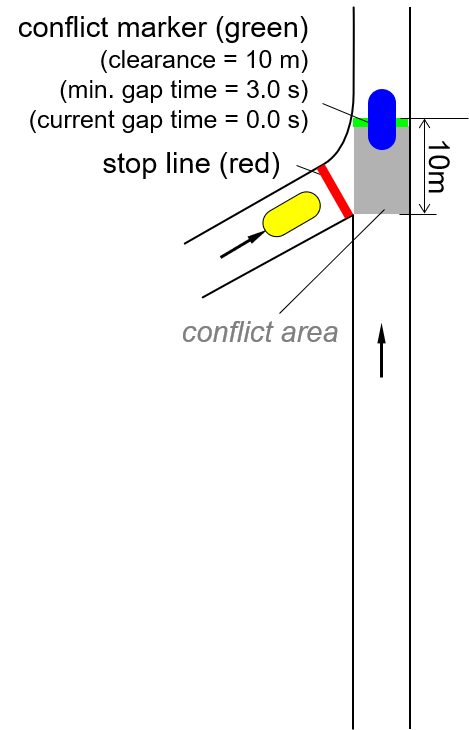Creating priority rules
A priority rule always consists of at least two elements:
- Red bar: Stop line of the traffic which must wait, and therefore the conflicting markers, in the image below
- Green bar: One or more conflicting markers, in the top-right of the image

The Min. Clearance indicates the distance from the conflicting marker (green line) against the movement direction up to the first vehicle which is moving towards the conflicting marker. If a vehicle is still within the conflicting marker, the min. clearance = 0.
If a vehicle travels to a stop line, Vissim checks whether the prescribed value for the minimum clearance and the minimum time gap upstream of the conflicting markers are present.
If the prescribed values are not present, the vehicle waits until both gaps are sufficiently long.
Min. clearance: For selected priority rules, green triangles in movement direction indicate a minimum clearance > 0 as distance between the conflict marker and the green triangle:

The green triangle for the min. clearance of a conflict marker is not displayed if the min. clearance is ZERO.
The conflict marker (in figures the top green bar on the left) also detects vehicles on all connectors, which lead upstream of the green bar onto the link. This behavior causes problems if the waiting vehicle is also detected by the conflict marker, for example if it is in the area of the min. clearance of the green bar. To avoid this, always position the green bar on a link upstream of the end points of the relevant connectors to the link.

Min. Gap Time: The available time gap is the time that the first upstream vehicle will require in order to reach the green bar of the conflicting marker with its present speed. A vehicle which is already on the green bar is not taken into account. In a priority rule, the limiting time gap is specified: The vehicle must wait if the current time gap is less than the value which has been entered.
Depending on the situation which is to be modeled, either the min. clearance or the limiting time gap is more important.
- Primarily, vehicles in a flow which has to wait in order to enter a flow which has priority, or which wish to cross such a flow, are oriented to the time gap.
- The min. clearance is used if it has to be established whether a conflicting vehicle has already reached a certain location.
As well as this, the relevance depends on the ease of flow of the traffic in the conflicting marker:
- For a normal traffic flow, it is mainly the time gap which is relevant.
- In the case of slow-moving traffic and congestion, the min. clearance is relevant.
In order that a vehicle does not need to stop and wait at a stop line, the conditions for all of the associated conflicting marker must be fulfilled.
For each red line (conflicting marker) Vissim takes one or several green bars (conflict markers) into account. Because of this, several different rules may apply for a stop line (red bar).
In the attributes, you may e.g. enter the following data:
- the vehicle classes of vehicles at the stop line
- The vehicle classes of the conflicting marker of the vehicle
- The maximum speed which a vehicle in the priority flow may still have in order for it to be recognized as a conflicting vehicle
Red and green bars for conflicting and conflict markers can be specific to the route or to the traffic lane.
In order to simplify the modeling, both red and green bars may apply for All lanes. It is then sufficient to insert a single priority rule. If you have to use different attribute values, which are specific to different traffic lanes, you must define the appropriate number of green bars (conflict markers).
|
|
Note: If it appears that vehicles ignore the priority rules, this may be due to the fact that the priority rules are so defined that vehicles have to wait for themselves or have to wait for each other. Vissim resolves this deadlock. The vehicle with the longest waiting time may drive off first. |
Examples for behavior at a junction with priority rule
In the following figure, the blue vehicle on the left of the main road is traveling at a speed of 50 km/h (approx.14 m/s) and is 49 m upstream of the conflict marker. The present time gap is 49 m / 14 m/s = 3.5 sec. As the minimum time gap is 3.0 sec, the yellow vehicle at the bottom can enter from the side road.

In the following figure, the blue vehicle is still only 28 m from the conflicting marker. The present time gap is 28 m / 14 m/s = 2 s. As the minimum time gap is 3.0 sec, the yellow vehicle must wait:

In the following figure, the front end of the blue vehicle has just traversed the conflict marker. Therefore, the present time gap is 0 sec. However, the yellow vehicle must wait until the rear edge of the blue vehicle has completely cleared the conflict area, as the min. clearance is greater than 0 m.

Superordinate topic:
Information on editing:


